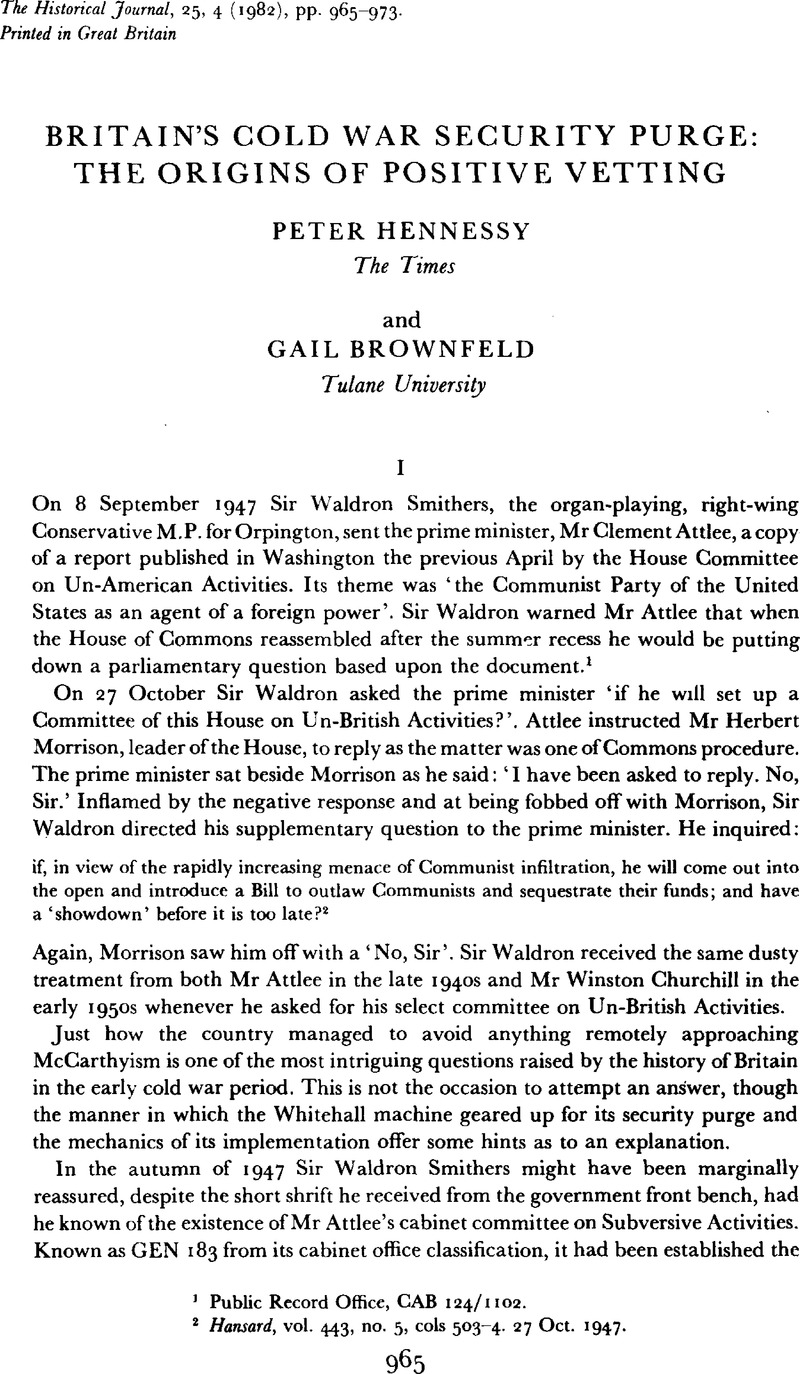Published online by Cambridge University Press: 11 February 2009

1 Public Record Office, CAB 124/1102.
2 Hansard, vol. 443, no. 5, cols 503–4. 27 Oct. 1947.
3 GEN 183 files remain closed. But the cabinet office catalogue at the P.R.O. shows that its initial paper was circulated on 29 May 1947. Its members met on 16 June for the first time.
4 See his obituary in The Times, 2 July 1982.
5 The best account of the Gouzenko defection and the events it precipitated can be found in H. Montgomery Hyde, The atom bomb spies (London, 1980).Google Scholar
6 See 'saga of the KGB mole in MI5’, The Times, 26 Oct. 1981.
7 Duff, Cooper, Old men forget (London, 1953), p. 205.Google Scholar
8 Private information.
9 As Sir John Winnifrith, he was permanent secretary to the ministry of agriculture, 1959–67.
10 Mr Mitchell retired in 1963 as deputy director-general of MI5.
11 The most recent being the Diplock Report, 'statement on the recommendations of the Security Commission’, Cmnd. 8540 (HMSO, May 1982).
12 Generally thought to have been Sir Roger Hollis, director-general of MI5, 1956–65, who was cleared of accusations that he himself had spied for Russia by Mrs Thatcher in the House of Commons in March 1981.
13 Private information.
14 Private information. Some of the background to the announcement can be found in PRO, PREM 8/948.
15 PRO, PREM 8/948.
16 Ibid.
17 Director-general of the Post Office, 1939–45.
18 Deputy secretary, ministry of labour and national service, 1942–5.
19 Former general secretary of the Union of Post Office Workers, he had been appointed to the board to assuage TUC complaints about the absence of union representatives from appeal hearings.
20 PRO, PREM 8/948.
21 Private information.
22 Private information.
23 Margaret, Gowing, Independence and deterrence, 11: Policy execution (London, 1974), p. 145.Google Scholar
24 Montgomery Hyde, Atom bomb spies, p. 222.
25 PRO CAB 21/2248.
26 Gowing, , Independence and deterrence. 1: Policy making (London, 1974), p. 300.Google Scholar
27 CAB 21/2248.
28 Ibid.
29 Gowing, Independence and deterrence, 1, 305. PRO CM (51) 58. CAB 128/20.
30 His article was summarized in The Times, 14 Dec. 1953.
31 CAB 21/2251.
32 CM (51) 58. CAB 128/20.
33 Conversation with Sir John Winnifrith, 31 July 1982.
34 Security procedures in the public service, Cmnd. 1681 (HMSO, 1962).
35 Cmnd. 8540.
36 ‘Making Whitehall mole-proof’, The Economist (5 June 1982).
37 Ibid.
38 The Times, 6 Jan. 1981.
39 Private information.
40 Kim Philby was a member of the Secret Intelligence Service, MI6, who defected to the Soviet Union in 1963. Andrew, Boyle, The climate of treason, revised paperback edition (London, 1980), p. 422.Google Scholar
41 Richard, Rovere, Senator Joe McCarthy, paperback edition (Cleveland and New York, 1966), p. 10.Google Scholar
42 David, Caute, The great fear (London, 1978), pp. 20–1.Google Scholar
43 Contained in Daniel, Bell (ed.), The radical right, paperback edition (New York, 1964), pp. 269–307.Google Scholar
44 Edward, Shils, The torment of secrecy (London, 1956), especially section iv of ch. 2.Google Scholar
45 Conversation with Sir John Winnifrith, 31 July 1982.